The tradition of electing Royal Benchers at the Inns of Court has its origins in the relatively recent past. While the first known Royal Bencher was James, Duke of York, later King James II (1633-1701), a Bencher of Inner Temple from November 1661, the custom of routinely electing a Royal Bencher at each Inn of Court only began two hundred years later. The Royal Bencher that established this new tradition was HRH Albert Edward, Prince of Wales, later HM King Edward VII, elected to the Bench in 1861 to the great pride of the membership.
Print of Albert, Prince of Wales opening the new Middle Temple Library, 1861 (MT/19/ILL/D/D6/4)
On 31 October 1861, at the young age of nineteen, the Prince of Wales was first Called to the Bar and then elected to the Bench of the Middle Temple – an occasion that was ‘the most important ceremonial in which he has engaged in this country’. This was mere weeks prior to an infamous visit by his father, Prince Albert, to issue a reprimand for ‘dissolute’ behaviour – a visit that Queen Victoria would forever blame for her beloved husband’s death on 14 December 1861. However, in October that year there was no hint of the troubled times to come. The Benchers of the Inn planned solemn ceremonials for the Prince’s Call to the Bench, which took place at the first meeting of Parliament to be held in the new Parliament Chamber. After these proceedings, the Bench, including their new Bencher, proceeded to the newly constructed neo-gothic Library Building, which was then ceremonially opened by the Prince of Wales. In addition to many members being in attendance at the ceremony, each Bencher was allocated tickets for three ladies and it was said that ‘the varied hues of their morning costumes were absolutely necessary in an artistic point of view to relieve the sombre monotony of the wigs and gowns’.
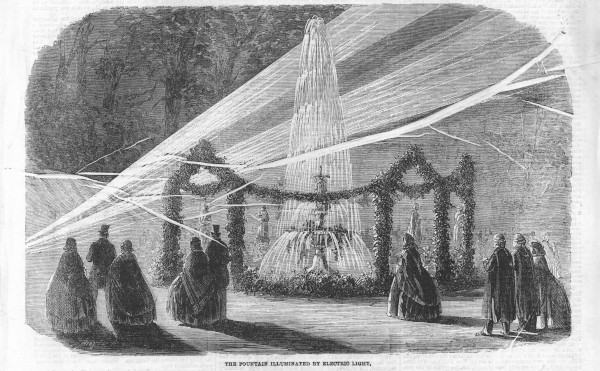
Print of Middle Temple’s Fountain illuminated by electric light for the opening of the New Library by the Prince of Wales, 9 November 1861 (MT/19/SCR/1)
The Inn was elaborately decorated for the Call of its first Royal Bencher. A massive edifice of canvas was erected in Fountain Court, which was adorned with statuary, flowers and ‘plate-glass’, and the fountain was illuminated with electric lights, an extremely novel technology. Here guests alighted from their carriages and a guard of honour was drawn up for the Prince of Wales. A huge dining pavilion lay beyond this, which accommodated 500 diners, and a corridor was created down to the garden illuminated with gas pendants. A magnificent luncheon or ‘dejeuner’ was provided for guests and a ‘conversazione’, a social gathering for conversation and discussion, was held in the Library during the evening after the departure of the Prince.
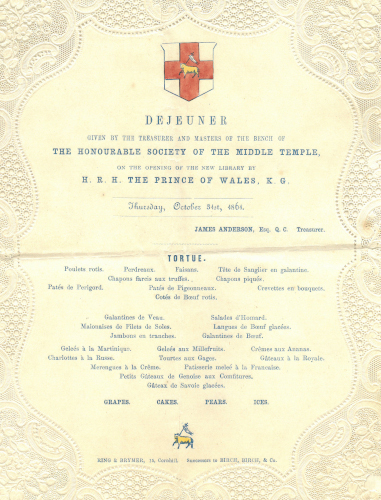
Menu for the ‘dejeuner’ held on the opening of the new Library by the Prince of Wales, 31 October 1861 (MT/7/ROY/3/1)
In order to honour their Royal Bencher, the Inn commissioned a portrait in 1877 from George Watts OM RA. Watts advanced far with the painting and completed multiple sittings with the Prince of Wales. However, due to His Royal Highness’ busy schedule, the sittings were irregular and painted in different lights. Watts also had to retouch the painting without the presence of the sitter. He was dissatisfied with the work and discontinued the project in 1880, refunding his fee and recommending the artist Frank Holl RA for the commission. The Middle Temple followed Watts’ recommendation of commissioning Holl, and the final painting was completed in 1884. The portrait was not universally admired – as one columnist politely stated, ‘opinions differ, perhaps as to the artistic merits of this portrait, which certainly contains an enormous amount of background, and is of very large size indeed’, though the Prince was said to ‘much admire the picture’.
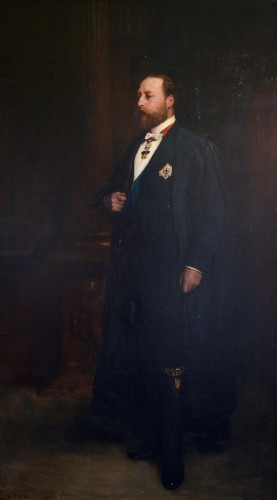
Portrait of Albert Edward, Prince of Wales in a Bencher’s gown, 1884
1887 was the year of Queen Victoria’s Golden Jubilee and the occasion was marked at the Middle Temple by inviting the Prince of Wales to be their first Royal Treasurer. He was duly confirmed Treasurer on 19 November 1886 ‘for the year ensuing’. However, his position as Treasurer was largely ceremonial and a Deputy Treasurer, Peter Henry Edlin, was appointed to perform the practical duties of the position during his year of office, though the Prince’s secretary was keen to ‘express the hope that as H.R.H. takes a great interest in the affairs of the Inn, you will at no time hesitate to refer to him in the event of any matter of difficulty or gravity arising in connection with the office’.
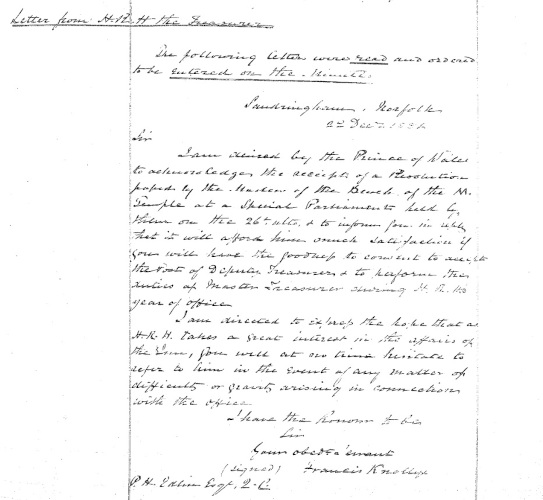
Record of a letter received from HRH The Treasurer in the Minutes of Parliament, 8 December 1886 (MT/1/MPA/19)
After his Treasurership, the Prince of Wales was sent the traditional £100 granted to holders of the office. His Royal Highness refused to keep the money and gave it instead to his Deputy Treasurer, Sir Peter Edlin. Sir Peter refused to keep the fee and recommended that it be employed for the ancient custom of purchasing silver plate for the Inn. The piece of plate chosen was a silver-gilt two-handled Cup and Cover in Neo Classical style, produced in 1800. The precise provenance of the Cup is unknown, but it has been speculated that it may previously have formed part of the Royal Collection. The Cup is engraved with the arms of the Prince of Wales and the Middle Temple to commemorate his Treasurership and is inscribed with the name of both His Royal Highness and his Deputy Treasurer. This Cup was used as a Loving Cup on Grand Days and during Readers’ Feasts as late as the 2000s.
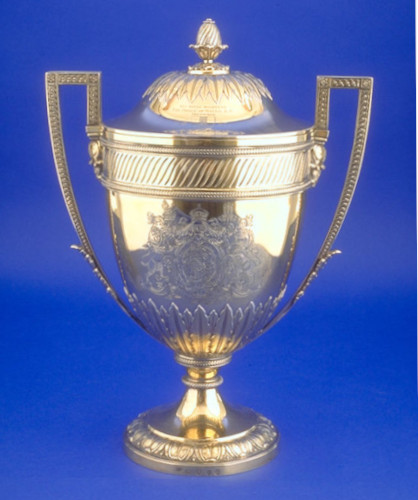
Silver-gilt two-handled Cup and Cover, 1800, donated by Albert, Prince of Wales on the recommendation of Sir Peter Edlin, 1888
On 24 February 1888, a committee was formed to discuss a presentation to Master the Prince of Wales on the occasion of his silver wedding anniversary. The Prince’s marriage to Princess Alexandra of Denmark had originally been celebrated in 1863 by providing a grand dinner to members of the Inn. While the couple were affectionate towards each other and had many children, Princess Alexandra was forced to close her eyes to her husband’s many infidelities during the long course of their marriage to maintain their relationship. It appears that the Inn settled upon a simple address as a fitting way to mark this milestone anniversary, as a letter from the secretary to the Prince and Princess of Wales acknowledged receipt of this and expressed ‘the sincere thanks and cordial appreciation of their Royal Highnesses for their congratulations and good wishes’. The couple would be married for a total of forty-seven years and were finally separated by the death of the Prince, then King, in 1910.
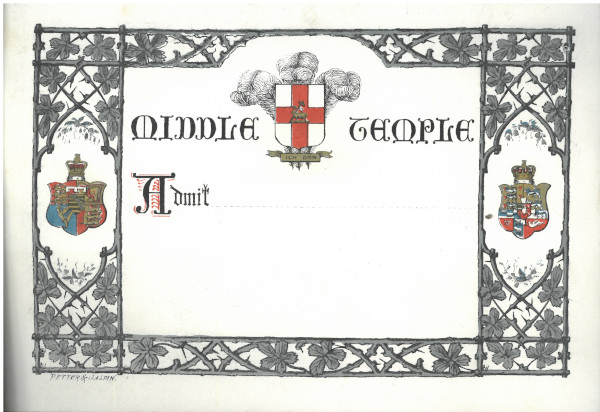
Illuminated ticket of admission to the Middle Temple for celebrations to the marriage of the Prince of Wales and Princess Alexandra of Denmark, 1863 (MT/7/ROY/3/6)
The Prince of Wales had a reputation for breaking rules and conventions, and this characteristic also emerged at the Middle Temple. He was credited with breaking the taboo around smoking in Hall when he dined there with his son, Prince Albert Victor (1864-1892), also a Bencher of the Inn, in the late 1880s. Popular legend states that after dinner the Prince pulled out a cigar and proceeded to smoke it. ‘The roof did not fall nor the floor open, though it is said that an old servitor of the Inn nearly fainted at the innovation’. The long convention of smoking being forbidden in Hall ‘vanished with the first puff from the Royal cigar’ and smoking was from that day allowed after dinner on Grand Days at the Middle Temple.
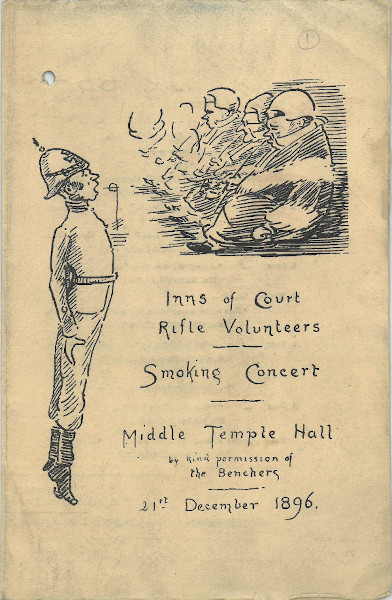
Programme of a Smoking Concert held in Hall and attended by the Prince of Wales, 21 December 1896 (MT/17/6)
After Albert, Prince of Wales ascended the throne as King Edward VII in 1901, there was speculation in the press as to whether he would continue in the capacity of Bencher of the Middle Temple. One columnist, published in the Shipley Times and Express, wrote ‘The King will not be seen again as a Bencher dining in the Hall of the Middle Temple, to which he was Called just forty years ago, but it is probable that his Majesty will sever his entire connexion with the Temple’. Perhaps in an attempt to quash this speculation, the inaccurate claim was put about that King Charles II had also been a Bencher the Middle Temple, as if this was the case ‘it would be in accordance with the fitness of things that the King of England of the time should, like Charles II and his present Most Gracious Majesty, be Benchers of the Inn which claims to number them among its members’. Fortunately, the dire predictions of certain members of the press did not come to pass, and the King retained his status as a Bencher, ‘one of the few positions that His Majesty thought fit to continue to retain as not incompatible with his kingly dignity’.
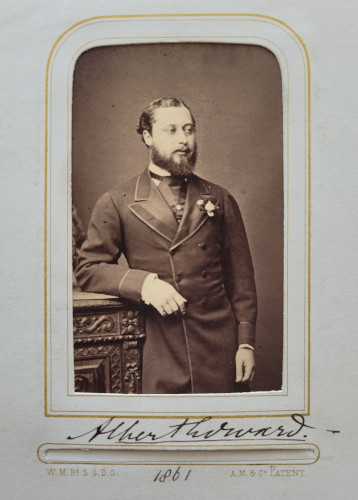
Photograph of Albert, Prince of Wales from a photograph album containing images of the Inn’s Benchers, 1864 (MT/3/BEF)
The King had visited the Middle Temple on many occasions as Prince of Wales, but his attendance at Grand Day 1903 was of particular significance to the Society as the first time that it had hosted a reigning monarch for dinner. Due to high demand, a ballot had to be created for allocation of the 200 dining places and there was extensive press coverage of the event, with the Illustrated London News hailing it as ‘The greatest social event in the history of the Middle Temple’. A guard of honour was provided by the Inns of Court Rifle Volunteers, known as ‘The Devil’s Own’, and a specially constituted military band played in the Hall Gallery during the evening. The event was also notable as the first occasion that our Royal Bencher had dined in Middle Temple Hall under the glow of the new electric light, which had been installed during the 1890s. The evening ran from eight to half-past eleven and as the King’s carriage drove down the Embankment at the end of the night, he was greeted by cheers.
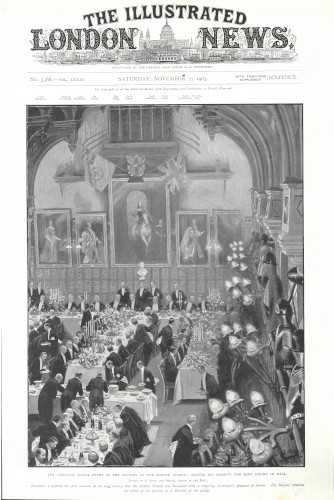
Drawing of King Edward VII dining in Hall on Grand Day, in the Illustrated London News, 7 November 1903 (MT/19/ILL/D/D2/51)
In 1904, to celebrate the coronation of the King, the first reigning monarch to be a Bencher of the Inn, the Benchers commissioned an extremely large and elaborate silver-gilt Pedestal Cup and Cover as well as four silver-gilt Standing Salts for the sum of around £1000, which would be equivalent to 100 times that amount today. A design competition was announced by the Society and several silversmiths created designs in the hope of winning the commission. Mappin Brothers was decided on for the creation of the Cup and Cover and two of the Standing Salts, and William Hutton & Sons created an additional two Standing Salts. The design of these pieces incorporate elements representing the King, the constituent parts of the United Kingdom and the British Empire, and also elements representing the heritage of the Middle Temple.
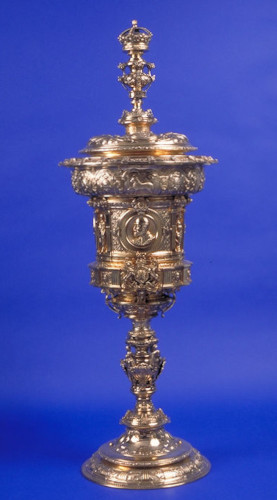
Massive silver-gilt pedestal Cup and Cover commissioned from Mappin Brothers, silversmiths, to celebrate the coronation of King Edward VII, 1904
In 1907, the King became a Senior Bencher of the Inn. Accidentally coinciding with this milestone, earlier that year two colourful gilt Royal coats of arms had been commissioned by the Society. Permission was sought from the Secretary of State for the King’s approval of the display of the arms, which was granted. The coats of arms chosen for display were the arms of Queen Elizabeth I and Edward VII, one celebrating the Inn’s historic connections with the Tudor monarch, and one to celebrate its long-standing relationship with the present King. These arms currently hang at the west end of Hall, above the Royal portraits.
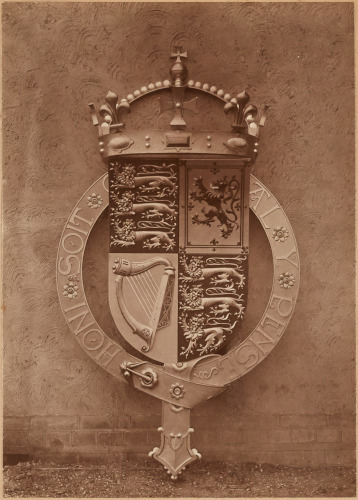
Photograph of the coat of arms of King Edward VII hanging in Middle Temple Hall, 1907 (MT/19/ILL/D/D2/12)
After King Edward’s death on 6 May 1910, the Benchers of the Inn decided to celebrate the former King’s long association with the Society by providing the sum of 100 guineas on his birthday every year ‘to be applied in assisting members of the Middle Temple to pursue study and research connected with English and foreign law, comparative legislation, and legal history, or such other subjects connected with the profession of the law…’ This annual grant became the King Edward Memorial Fund for Legal Study and Research. King Edward was also posthumously commemorated by the loan of a portrait of him from the Royal Collection in the 1960s. This currently hangs prominently in the Parliament Chamber and has for the last sixty years observed the governance of the Middle Temple.
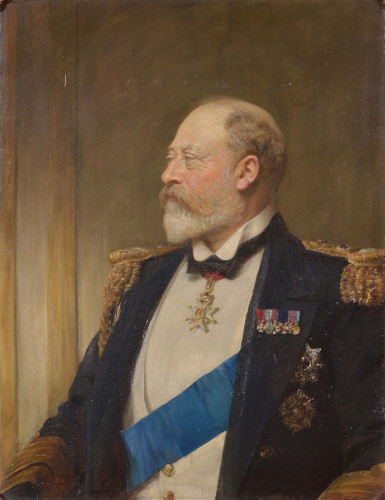
Posthumous portrait of King Edward VII, 1911 (Royal Collection Trust © His Majesty King Charles III 2023)
King Edward VII, though suffering from a poor reputation for idleness and dissipation when he was the Prince of Wales, added greatly to the prestige of the Middle Temple by becoming its first Royal Bencher. His election was a source of pride for the Inn and a generated a large amount of positive press coverage over the course of his long membership. As well as expressing interest in the affairs of the institution, the King’s famously extroverted personality generated delight among his dining companions and broke long-standing conventions of the Society.